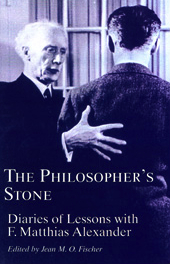


The Philosopher's Stone:
Diaries of Lessons with F. Matthias Alexander
A Review by Kevin Ahern
“Mrs. Hand's ‘it is such a problem not to want to be right’ will strike a familiar chord in many readers.”
Here is the latest in a series of publications and/or re-publications by Mouritz of London concerning the work and writings of F. M. Alexander. As did the previous releases, Articles and Lectures (1995), and Man's Supreme Inheritance (1996), this book helps us look at the development of Alexander's work over time, from c. 1918 to c. 1953. Contrasted with the previous releases, which gave us mostly the thoughts and accounts of Alexander himself, this title gives us the written accounts of a variety of individuals coming to the work at different stages in its development. These students differed in their backgrounds, purposes, insights, and ages and so give each of us, differing as we do, a variety of perspectives from which to glimpse our own development in this work.
The chronological order in which the diarists came to the Technique (which is not the order in which their accounts come in the book) is J.H. Robinson (~1919), A.M. Ludovici (1925), George Trevelyan (1928-1937), Frank and Grace Hand (1942), Eva Webb (1947), Mrs. Buchanan (1952). Most seem to have had only one series of lessons over a relatively short period of time but Ludovici says his lessons in ‘deportment’ went on for four years and Trevelyan, who trained to become an Alexander teacher, had lessons for many years. Some of these accounts were written contemporaneously with lessons and some were written months or years later.
James Harvey Robinson was a well-known teacher, author, and social activist of his time. He was one of the co-founders of the New School for Social Research in New York City. His work with Alexander clearly helped him recover from “a lifelong personal experience of physical and mental depression.”
A.M. Ludovici , a prolific author and translator, gives a comic account of his own strenuous efforts to avoid having lessons with Alexander. He clearly changed his mind. In this account, written over three decades after his lessons with F. M., he is still exclaiming over “the benefits both in health and in joie de vivre which I owed, and still owe, to this radical alteration in my physique.”
George Trevelyan's section is nearly twice as long as any other and is of interest because of its extent and detail. It ranges from his first experiences and thoughts on the Technique to a period after he had trained and was trying to make a go of it as an Alexander teacher.
Grace and Frank Hand, mother and son, had lessons on the recommendation of the leader of their offshoot Christian Science group. Mrs. Hand's “it is such a problem not to want to be right” will strike a familiar chord in many readers.
I feel a whimsically special connection with Eva Webb. She had her first lesson, with F. M., on the day I was born. Apart from that, I admire that she, a self-described “busy housewife,” appears to have come to the Technique through extensive and thoughtful reading. She wanted her whole family to have lessons, but when that proved impossible, she didn't let that stop her from going ahead on her own.
I also admire Mrs. Buchanan for her thoughtfulness under dire stress. She overheard two of her consulting doctors describing her case as hopeless, but was able, in consideration for their feelings, not to reveal what she had heard. This makes the account of her recovery from near death to a renewed life through lessons with F. M. even more heart-warming.
There are some interesting similarities and/or connections between these widely different individuals. Several of them can be described as belonging to the “intellectual” class of their time. George Trevelyan and Agnes Birrell (A. M. Ludovici's persistent “angel”) both had family connections to the British Ministry and Board of Education in the early 1900's. Most of them started lessons due to the urging of someone they respected (although Ludovici's respect for Birrell took time and some strange manifestations before bearing fruit). Most, in their accounts of their lessons and the resulting changes in themselves, give a sense of dramatically “physical” experiences with renewed enjoyment of themselves and living.
Editor Jean Fischer, in his habitually excellent way, has supplied a wealth of supplementary information in the footnotes and in his Introduction. The Introduction also has a thoughtful exposition on the place that diary accounts such as these might play in our own study of Alexander's work. In addition the book includes a series of nineteen marvelous and varied photographs of an older F.M. at work, teaching.
Copyright 1998 Kevin Ahern
About the Author
Kevin Ahern trained with Joan and Alexander Murray from 1977 to 1980 at the Urbana Center for the Alexander Technique. He has taught the Technique in Wisconsin, Michigan, and Seattle, Washington. He currently resides in and maintains a private teaching practice in Kaneohe, Hawaii.
Contact the author Kevin Ahern
The Philosopher's Stone is available from Mouritz.
Links
John Dewey and the Alexander Technique
Back to
Book Reviews Index
The Insiders' Guide to the Alexander Technique
Alexander Technique: The Insiders’ Guide
maintained by Marian Goldberg, MSTAT
Alexander Technique Center of Washington, D.C.
info@alexandercenter.com